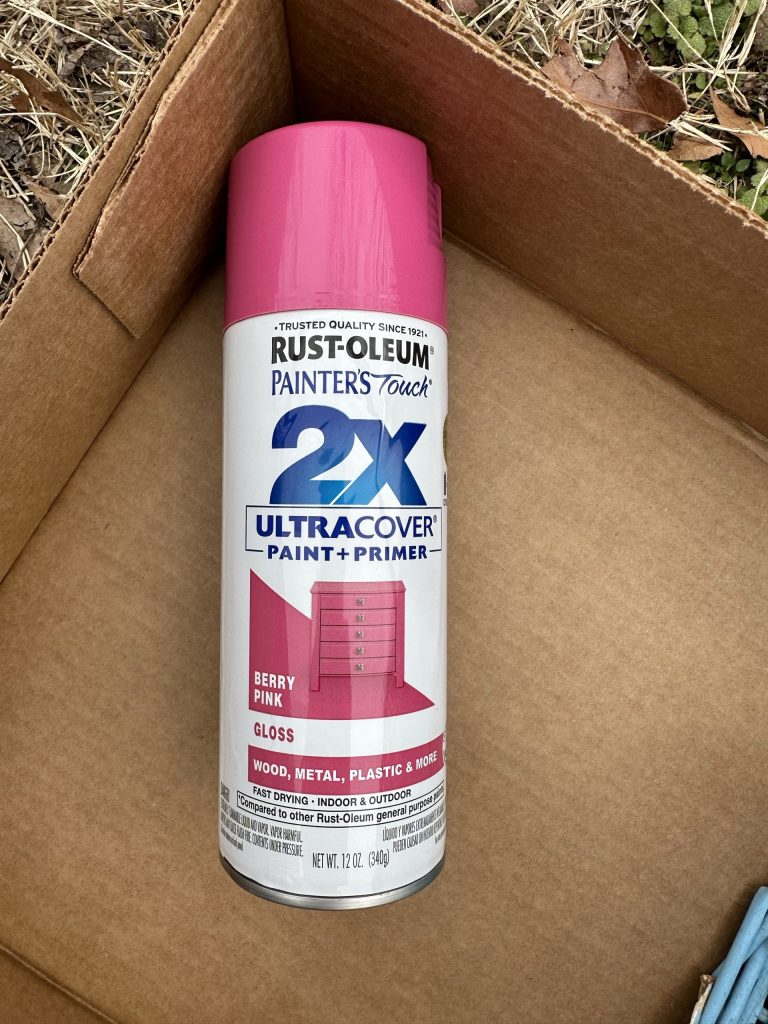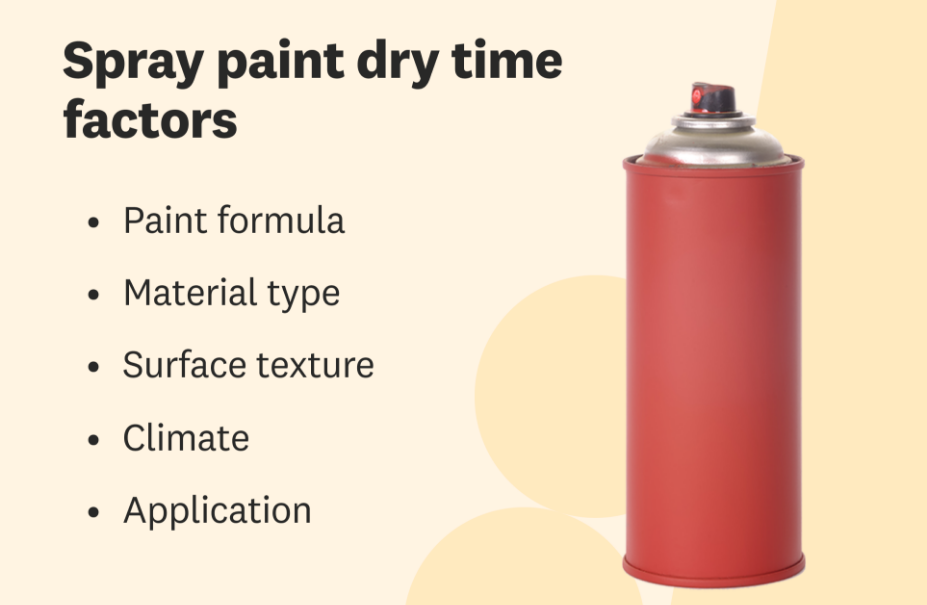Spray paint is a popular choice for quick and efficient painting projects. Knowing how long it takes for spray paint to fully cure is crucial for optimal results. The curing process involves the paint hardening and reaching its maximum durability.
This often takes about 24 hours under ideal conditions. Factors such as humidity, temperature, and the type of surface can influence drying times. Proper preparation and patience ensure a smooth, long-lasting finish. Whether you’re working on furniture, crafts, or automotive parts, understanding the curing time helps you plan your project effectively and achieve professional results.
Factors Affecting Cure Time
The time it takes for spray paint to fully cure can vary. Several factors influence this curing process. Understanding these factors can help you achieve the best results.
Type Of Paint
Different types of spray paints have different cure times. Acrylic paints typically cure faster than enamel paints. For example, acrylics may take around 24 hours to cure. In contrast, enamels can take up to 7 days.
- Acrylic Paints: Faster curing, around 24 hours.
- Enamel Paints: Slower curing, up to 7 days.
- Lacquer Paints: Medium curing, around 3 days.
Environmental Conditions
Temperature and humidity play crucial roles in the curing process. High temperatures speed up curing, while low temperatures slow it down. Ideal temperatures range between 65°F to 85°F (18°C to 29°C).
Humidity also affects the cure time. High humidity levels increase the drying time. Lower humidity levels reduce it. Keep humidity levels between 40% and 50% for optimal results.
| Condition | Effect on Cure Time |
|---|---|
| High Temperature (above 85°F) | Speeds up curing |
| Low Temperature (below 65°F) | Slows down curing |
| High Humidity (above 50%) | Increases drying time |
| Low Humidity (below 40%) | Reduces drying time |
However, Proper ventilation also helps in the curing process. Ensure the painted area has good airflow. This helps the paint to dry and cure more efficiently.
:max_bytes(150000):strip_icc()/how-to-spray-paint-furniture-5198299-10-2ecc9ce724ac45589e8083c06300f2c0.jpg)
Different Surfaces
Spray paint curing times vary based on the surface. Different materials absorb paint differently. Knowing this helps achieve the best results.
Metal
Metal surfaces are smooth and non-porous. Spray paint on metal usually takes 24 hours to dry. Full curing may take up to 7 days. Ensure you clean and sand the metal first. This helps the paint adhere better.
| Step | Time |
|---|---|
| Dry to Touch | 30 minutes |
| Handle | 1-2 hours |
| Fully Cured | 7 days |
Wood
Wood surfaces absorb paint quickly. Spray paint on wood can dry in 1 hour. Full curing may take up to 3 days. Sand the wood for a smooth finish. Use primer for better adhesion.
- Dry to Touch: 1 hour
- Handle: 2-3 hours
- Fully Cured: 3 days
Plastic
Plastic surfaces are tricky. Spray paint on plastic can dry in 30 minutes. Full curing may take up to 7 days. Use a primer made for plastic. This helps the paint stick well.
- Dry to Touch: 30 minutes
- Handle: 1-2 hours
- Fully Cured: 7 days
Stages Of Curing
Understanding the stages of curing is crucial for achieving a perfect spray paint finish. Each stage has unique properties and durations. Let’s delve into the three key stages: Initial Drying, Hardening Phase, and Full Cure.
Initial Drying
The initial drying stage starts immediately after applying the spray paint. This stage allows the surface to dry to the touch. In this phase, the paint’s solvents evaporate, forming a thin skin. The surface may feel dry but isn’t ready for handling. The duration of this stage typically ranges from 15 minutes to 1 hour, depending on the paint type and environmental conditions.
Hardening Phase
During the hardening phase, the paint becomes more resilient. This phase ensures the paint adheres firmly to the surface. The paint gains more resistance to scratches and dents. The hardening phase can take from 24 hours to 7 days. Factors like humidity and temperature influence this phase. Ensure the painted item remains undisturbed during this time.
Full Cure
The full cure stage marks the completion of the curing process. At this point, the paint reaches its maximum hardness and durability. The paint is now fully bonded to the surface. This stage can take anywhere from 7 days to 30 days. During the full cure stage, avoid exposing the painted item to harsh conditions. Full cure guarantees the best performance and longevity of the paint job.
| Stage | Duration | Description |
|---|---|---|
| Initial Drying | 15 minutes to 1 hour | Surface feels dry to the touch. |
| Hardening Phase | 24 hours to 7 days | Paint becomes more resilient and adheres firmly. |
| Full Cure | 7 days to 30 days | Paint reaches maximum hardness and durability. |
Expert Tips For Faster Curing
Spray paint can transform any project, but waiting for it to cure can test your patience. Speeding up the curing process is possible with some expert tips. This section shares secrets to make your spray paint cure faster.
Temperature Control
Keep the temperature between 65-85°F (18-29°C) for faster curing. Extreme temperatures slow down the process. Use a heater in cold weather. A fan can help distribute heat evenly. Avoid direct sunlight as it can cause uneven drying.
Humidity Management
Low humidity helps spray paint cure faster. Ideal humidity levels are below 50%. Use a dehumidifier in humid environments. Keep your workspace dry. Moisture can slow down curing.
Airflow Enhancement
Proper airflow is essential for faster curing. Open windows or doors to improve ventilation. Use fans to circulate air. Position fans to blow across the painted surface. Avoid too much wind, which can cause dust to settle on the paint.
Common Mistakes
Understanding how long spray paint takes to fully cure is crucial for achieving the perfect finish. Many people make common mistakes that can delay the curing process. Avoiding these mistakes ensures your project looks professional and lasts longer.
Thick Coats
Applying thick coats of spray paint is a common mistake. Thick layers take longer to dry and cure. Instead, use thin, even coats. This helps the paint dry faster and cures properly.
- Apply multiple thin coats
- Wait a few minutes between coats
- Ensure each layer is even
Poor Ventilation
Painting in an area with poor ventilation can slow down the curing process. Good airflow helps the paint dry and cure faster.
| Condition | Effect on Drying |
|---|---|
| Good Ventilation | Faster Drying |
| Poor Ventilation | Slower Drying |
Make sure to paint in a well-ventilated area. Open windows or use fans to improve airflow.
Inadequate Drying Time
Not allowing adequate drying time between coats is another frequent error. Rushing the process can lead to a tacky, uneven finish.
- Wait at least 15 minutes between coats
- Check if the surface is dry to the touch
- Allow more time in humid conditions
Patience ensures a smooth and durable finish.
Testing For Full Cure
Testing for a full cure of spray paint is crucial. It ensures your paint job is ready for use. There are different methods to test for a full cure. These methods include the Touch Test, Scratch Test, and Solvent Test.
Touch Test
The Touch Test is the simplest method. Lightly touch the painted surface with your finger. If it feels sticky, the paint is not fully cured. If it feels dry and smooth, it might be fully cured.
Scratch Test
The Scratch Test can check the hardness of the paint. Use your fingernail or a coin to lightly scratch the surface. If the paint scratches easily, it is not fully cured. If it resists scratching, the paint may be fully cured.
Solvent Test
The Solvent Test is a bit more involved. Dampen a cloth with a solvent like acetone or rubbing alcohol. Gently rub the painted surface with the cloth. If the paint comes off or softens, it is not fully cured. If it remains unaffected, the paint is likely fully cured.
| Test | Method | Result |
|---|---|---|
| Touch Test | Touch the surface lightly | Sticky means not cured, dry means might be cured |
| Scratch Test | Scratch with fingernail or coin | Scratches easily means not cured, resists means might be cured |
| Solvent Test | Rub with solvent-dampened cloth | Softens or comes off means not cured, unaffected means likely cured |
Tools And Products
Knowing the right tools and products can speed up the curing process of spray paint. Using the right equipment can make a big difference. Let’s dive into some effective tools and products.
Heat Guns
A heat gun can significantly reduce the curing time of spray paint. Heat speeds up the drying process by evaporating solvents quickly.
- Set the heat gun to a low setting to avoid burning the paint.
- Keep the heat gun moving to distribute heat evenly.
- Hold the heat gun at least 6 inches away from the painted surface.
Dehumidifiers
Dehumidifiers remove moisture from the air, making the environment dryer. This helps the paint to dry and cure faster. High humidity can prolong the drying time.
| Benefit | Description |
|---|---|
| Faster Drying Time | Removes excess moisture from the air. |
| Improved Finish | Prevents paint from absorbing moisture. |
Specialty Paints
Specialty paints are designed to dry and cure faster. These paints often contain additives that speed up the drying process. Some specialty paints are also more durable.
- Read the label to understand the specific curing time.
- Use the recommended primer for best results.
- Apply in thin, even coats to ensure quick drying.
Using specialty paints can save time and provide a better finish.

Long-term Care
Understanding how long it takes for spray paint to fully cure is important. But taking care of it long-term is equally crucial. Proper care ensures the paint stays fresh and vibrant for years.
Cleaning Tips
Keeping your spray-painted items clean can extend their lifespan. Here are some simple tips:
- Use a soft cloth: Gently wipe the surface with a soft, dry cloth.
- Avoid harsh chemicals: Clean with mild soap and water only.
- Dry immediately: Always dry the surface after cleaning to prevent water spots.
Maintenance Practices
Regular maintenance can help keep the spray-painted surface in top condition. Follow these practices for the best results:
- Inspect regularly: Check for chips or scratches every month.
- Touch up as needed: Use matching spray paint for small repairs.
- Store properly: Keep spray-painted items in a cool, dry place.
| Action | Frequency |
|---|---|
| Inspect for damage | Monthly |
| Clean surface | As needed |
| Touch-up paint | As needed |
| Store properly | Always |

Frequently Asked Questions
How Long Does Spray Paint Take To Dry?
Spray paint typically dries to the touch in 30 minutes. However, full curing can take 24 hours or longer. Environmental factors like humidity and temperature can affect drying times.
What Affects Spray Paint Curing Time?
Several factors influence curing time, including temperature, humidity, and paint thickness. Higher humidity and lower temperatures slow down the curing process. Applying thin coats speeds up drying.
Can You Speed Up Spray Paint Curing?
Yes, you can speed up curing by using a heat source, like a hairdryer. Ensure good ventilation and apply thin coats. Avoid direct sunlight.
Is Spray Paint Safe After It Dries?
Spray paint is generally safe after it dries to the touch. However, it’s best to wait until it’s fully cured before handling. Full curing can take a few days.
Conclusion
Understanding the curing time for spray paint ensures a flawless finish. Patience is key for optimal results. Factors like temperature and humidity play crucial roles. Always follow the manufacturer’s guidelines. Proper curing guarantees durability and longevity of your paint job.
Enjoy your beautifully finished project!
